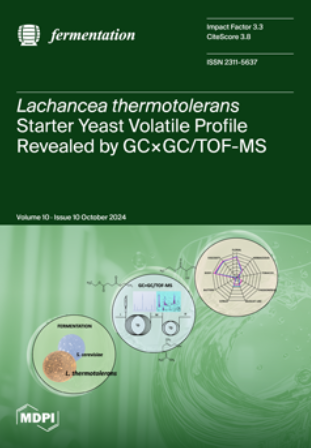Sequential Inoculation of Metschnikowia pulcherrima and Saccharomyces cerevisiae as a Biotechnological Tool to Increase the Terpenes Content of Pecorino White Wines
IF 3.3
3区 农林科学
Q2 BIOTECHNOLOGY & APPLIED MICROBIOLOGY
引用次数: 0
Abstract
The aim of this study was the evaluation of the effect of the sequential inoculation of Metschnikowia pulcherrima and Saccharomyces cerevisiae for the production of Pecorino wine on the winery scale. Sequential inoculation allowed for wines with interesting oenological characteristics to be obtained. In particular, these wines showed a lower ethanol content than those obtained with S. cerevisiae alone, and the presence of M. pulcherrima induced a reduction in the wine titratable and volatile acidity of about 30%. The effect of M. pulcherrima was relevant also in terms of the volatile profile of the wines. In fact, an increase in the esters content of 60% and a reduction of 53% of the acetic acid was observed. Moreover, the sequential inoculation resulted in an increase in the terpenes content of about 80%. The wines also showed a different sensory profile; in fact, the wines obtained with the sequential inoculation showed higher scores than the other wines for the following descriptors: floral, tropical fruit, citrusy, balsamic, and freshness.序贯接种pulcherrima和酿酒酵母提高Pecorino白葡萄酒中萜烯含量的研究
本研究的目的是评价序贯接种pulcherschnikowia和酿酒酵母(Saccharomyces cerevisiae)在酒厂规模生产佩科里诺葡萄酒中的效果。序贯接种可以获得具有有趣的酿酒特性的葡萄酒。特别是,这些葡萄酒的乙醇含量低于单独使用酿酒酵母获得的葡萄酒,并且M. pulcherrima的存在导致葡萄酒的可滴定性和挥发性酸度降低了约30%。M. pulcherrima的影响也与葡萄酒的挥发性特征有关。事实上,酯含量增加了60%,乙酸含量减少了53%。此外,顺序接种导致萜烯含量增加约80%。这两款葡萄酒也呈现出不同的感官特征;事实上,通过顺序接种获得的葡萄酒在以下描述项上比其他葡萄酒表现出更高的分数:花香、热带水果、柑橘味、香脂味和新鲜度。
本文章由计算机程序翻译,如有差异,请以英文原文为准。
求助全文
约1分钟内获得全文
求助全文
来源期刊

Fermentation-Basel
BIOTECHNOLOGY & APPLIED MICROBIOLOGY-
CiteScore
3.80
自引率
18.90%
发文量
594
审稿时长
7 weeks
期刊介绍:
Fermentation-Basel is an international open access journal published by MDPI, focusing on fermentation-related research, including new and emerging products, processes and technologies, such as biopharmaceuticals and biotech drugs. The journal enjoys a good reputation in the academic community and provides a high-impact forum for researchers in the field of bioengineering and applied microbiology.
 求助内容:
求助内容: 应助结果提醒方式:
应助结果提醒方式:


